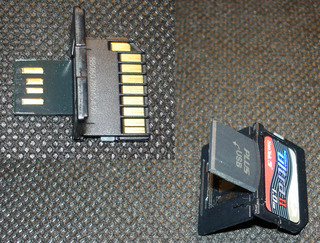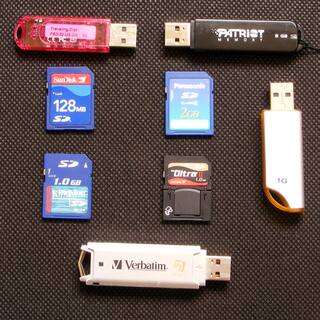 One special note for the Sandisk Ultra II SD card which has a built-in USB connector!
One special note for the Sandisk Ultra II SD card which has a built-in USB connector! This is a very nice feature that allows you to connect the card directly to the USB port.
I realized how important is not the capacity of a flash memory but also its speed.
Think of it: if you have a memory card with a write speed of only 1 MB/s, it will take 3 seconds to write a picture file on it. Which means that you must wait 3 seconds with your digital camera to be able to take the next shot (the size of a JPG compressed picture is about 3 MB in nowdays cameras with around 7 Mega Pixel resolution on High Quality)
Another example: with a USB memory stick with a speed of 2 MB/s it will take you more than half an hour to transfer a DVD (4 GB) !
You must be aware that the read speed is higher than the write speed so a manufacturer which states "high speed memory" may refer to the read speed only.
In computers the basic unit for measuring the information is the bit. But in practice it's easier to use the byte. I will not discuss the fact that the use of the byte is wrong because everyone uses it nowadays (the correct name would be "octet"). Let's use the byte with the meaning of 8 bit as everyone does. So, 1 MB is 1 Mega Byte and 1 Mb (with a small "b") will be 1 Megabit. I will be using only the byte unit when referring to the size of a memory.
Now we have another problem: How much is a MegaByte? (or a KiloByte or a GigaByte). Well, here again we have a misunderstanding, this time exploited by the marketing departments: computers are using binary mathematics, the term of "bit" is purely binary yet the vendors are imposing misleading terminology. If 1 Megabyte is exactly 1024 Kilobytes and 1048576 bytes the vendors are saying that 1 MB is 1000 Kilobytes and 1000000 (one million) of bytes.
The purpose of the whole discussion was to clarify why the brand new memory of 8 GB has in fact only 7.45 GB. And even less after formatting, but that's another discussion.
So I gathered all my USB memory sticks and SD cards and I made a test

In my personal collection there are all kind of USB memory sticks from an old 32 MB (the red one) to a quite new Patriot 8 GB (the black one).
For testing the memory sticks I was using my computer (a Dual Core Duo Pentium with an ASUS motherboard) and a ... watch for measuring the time for transferring the files. I also used the program HDTach.
For the SD cards I tried to use a GPS device (yep, as a SD-card reader) and a digital camera. Sadly, I noticed that my GPS device or the camera can't transfer data to the computer at speeds greater than 4 MB/s using the USB cable. I had a dedicated SD-card reader which stopped working but anyway it was slow. This is a remainder that even the dedicated SD-card readers don't allow a very fast transfer rate, except for the very good (and expensive) ones.
 One special note for the Sandisk Ultra II SD card which has a built-in USB connector!
One special note for the Sandisk Ultra II SD card which has a built-in USB connector!
This is a very nice feature that allows you to connect the card directly to the USB port.
All the memories were formatted before the test and I used exactly the same file for the tests in exactly the same conditions
The main test was the transfer of an avi movie with the size of a CD (700 MB). So this is a very big file and the transfer rate is the best. The time for transferring many small files is much higher.
The other test was done using the HDTach benchmark software. This test was done only for reading and it also shows the random access time (how quick the information is found on the memory).
For the read speed the two tests give close results.
| Manufacturer | Product | Capacity | Type | Write speed | Read speed | HDTach read speed | HDTach access time |
|---|---|---|---|---|---|---|---|
| Patriot | Signature | 8 GB | USB stick | 9.8 MB/s | 16.7 MB/s | 18.7 MB/s | 7.2 ms |
| Sandisk | Ultra II | 1 GB | SD Card w USB | 8.9 MB/s | 9.3 MB/s | 9.8 MB/s | 1.2 ms |
| Verbatim | Store'N Go U3 | 2 GB | USB stick | 3.3 MB/s | 11.5 MB/s | 12.4 MB/s | 0.5 ms |
| noname gray | Flash Disk 5.0 | 1 GB | USB stick | 2.1 MB/s | 9.6 MB/s | 10.3 MB/s | 0.6 ms |
| noname red | Traveling Disk | 32 MB | USB stick | n/a | n/a | 0.6 MB/s | 6 ms |
I think it's very clear that a low cost flash memory can be very slow.
Even if my test was done only for USB memory sticks it's easy to imagine that a slow SD card can be very frustrating in a digital camera.
I recommend to buy a good memory even if it has a smaller capacity than to buy for the same price a bigger and slower memory: for a digital camera one 1GB memory can hold around 300 pictures !
.Of course, if you use your digital camera for shooting movies you need a bigger memory card (and very fast, too). A slow memory will not allows you to shoot movies at good quality.
As for transferring data, the USB memory sticks should be fast if you plan to use them for large files. My no name 1 GB memory stick was more than four times slower than the Patriot (the writing speed is important): it took nearly 6 minutes for transferring a single AVI movie.
Sadly, the only information that manufacturers are giving sometimes about their products is a mysterious multiplier . In fact this "10x" or similar it's analogue with the old CD speed standard: 1x is 150 KB/s. So a very slow flash memory with only 1 MB/s transfer speed (like my old 32 MB) will be a 6x !!! My Patriot memory (the best in my test, but the cheapest from Patriot) would be a 110x in reading and 68x in writing.
Usually the manufacturer is referring to the read speed which can be even 4 times faster than the write speed
So, make you a favour and buy memories from big producers which can guarantee at least a minimum of performance
It's a good thing to search on the manufacturer's website what he has to tell for its product. If you can't find on Internet the company I suggest looking to another product. As I already said it's better to buy a smaller but a faster memory